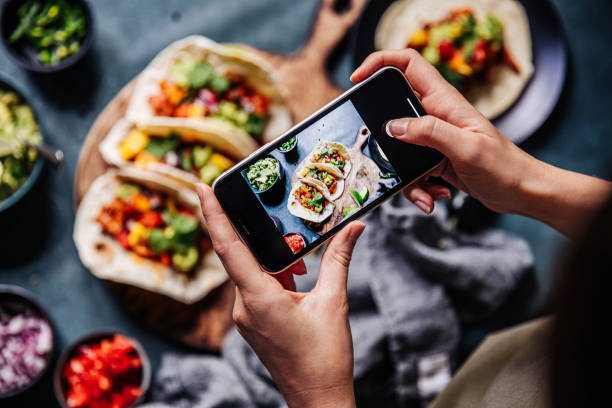Whether you’re a professional food blogger or just a foodie who loves sharing culinary creations on Instagram, capturing mouthwatering images of your meals is a must. Here are some tips to help you:
1. Perfect the Lighting
Lighting is the foundation of any great food photo. Natural light is your best friend when it comes to food photography. Position your dish near a window or a source of soft, diffused natural light. Avoid harsh, direct sunlight, which can create unattractive shadows. You can also use a reflector or a white foam board to bounce light onto your subject and fill in shadows.
2. Set the Stage
Create an inviting and aesthetically pleasing background for your food. Consider using wooden boards, marble slabs, or colorful tablecloths to set the stage for your meal. Experiment with various textures and colors to find what complements your food best. Just remember, the background should enhance, not overpower, your dish.
3. Use the Rule of Thirds
The rule of thirds is a fundamental principle in photography. Imagine your photo divided into nine equal parts with two equally spaced horizontal lines and two equally spaced vertical lines. Place the most important elements of your image, like the main dish or a garnish, along these lines or at their intersections. This technique adds balance and interest to your composition.
4. Mind the Angles
Experiment with different angles to find the most flattering perspective for your dish. The classic top-down shot, known as the “flat lay,” works well for many types of food. However, don’t hesitate to get creative with various angles, such as a 45-degree angle or a close-up macro shot. Each angle can highlight different aspects of the meal.
5. Keep It Neat and Tidy
Before taking the shot, inspect your dish for any smudges, spills, or imperfections. A pristine plate ensures your food looks its best in photos. You can use a clean cloth or a small brush to tidy up the dish and remove any distracting elements.
6. Consider the Color Palette
The colors in your photo should complement the food and create a harmonious visual experience. Think about the color wheel and choose backgrounds and props that contrast with the colors of your dish. This contrast will make the food pop and create an appealing image.
7. Focus on Details
Food photography is all about capturing the details that make your dish unique. Highlight the texture, patterns, and visual elements that make your meal special. Whether it’s the sprinkling of powdered sugar on a dessert or the steam rising from a hot dish, these details add depth and character to your photo.
8. Experiment with Depth of Field
Controlling the depth of field in your photos can create a captivating effect. A shallow depth of field, achieved with a wide aperture (e.g., f/2.8), can blur the background, making the food stand out. Conversely, a deep depth of field with a smaller aperture (e.g., f/8 or higher) can keep more of the scene in focus.
9. Add Props
Props can enhance the storytelling aspect of your food photos. Consider adding utensils, napkins, herbs, or ingredients that relate to the dish. Just be mindful not to overcrowd the frame; props should complement, not overshadow, the food.
10. Tell a Story
Food photos with a narrative element can be incredibly engaging. Showcase the preparation process, ingredients, or a bite being taken from the dish. These action shots can convey the story behind the meal and capture the viewer’s attention.
11. Play with Negative Space
Negative space is the empty area around the main subject of your photo. Using negative space effectively can create a sense of balance and draw the viewer’s eye to the food. Leaving some areas of your frame free of props or details can make your image feel more open and inviting.
12. Edit with Care
Editing your photos is the final step in creating stunning food images. Use photo editing apps or software to adjust brightness, contrast, color balance, and sharpness. Be cautious not to over-edit, as excessive filters or effects can make your food look unnatural.
13. Consistency Is Key
If you’re building an Instagram following with food photography, maintaining a consistent style and theme can be essential. Choose a color palette, composition style, and mood that align with your personal brand or the atmosphere you want to convey. Consistency will make your profile more visually appealing.
14. Use Quality Equipment
While you can take amazing food photos with a smartphone, investing in a good camera can take your photography to the next level. A DSLR or mirrorless camera with a variety of lenses provides greater control over settings, especially in challenging lighting conditions.
15. Practice and Patience
Great food photography takes practice and patience. Don’t be discouraged if your first shots don’t turn out as expected. Keep experimenting, trying different techniques, and refining your skills. You’ll gradually develop your unique style and improve the quality of your food photos.
16. Study the Masters
Study the work of renowned food photographers and follow Instagram accounts dedicated to food photography. Analyze their compositions, lighting, and techniques. Learning from the best can inspire your own creative approach.
17. Engage with Your Audience
When you post your food photos on Instagram, engage with your audience. Respond to comments, ask for feedback, and interact with the food photography community. Building a rapport with your followers can foster a supportive and enthusiastic community around your work.
18. Explore Editing Apps
There are plenty of photo editing apps available that can help you fine-tune your food photos. Adobe Lightroom, Snapseed, and VSCO are just a few examples. These apps offer various filters, presets, and adjustment tools to enhance your images.
19. Capture the Moment
While planning and styling are essential, don’t forget the joy of capturing a genuine, unscripted moment. Sometimes, the most authentic and mouthwatering food photos happen when you capture the spontaneity and pure delight of enjoying a delicious meal.

